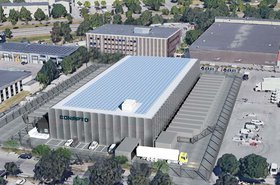Circular economy is all about a framework for an economy that is restorative and regenerative by design. Unlike in today’s linear economy, in a circular economy we see everything as a resource for something else – waste doesn’t exist.
Within the EU we produce more than 2.5 billion tons of waste every year. Until now we have lived with linear production models, in other words, we extract, produce, consume, and discard. The society in which we live means that the pace of consumption is accelerating, a model that is fast but unsustainable for the planet.
The circular economy establishes a more sustainable production and consumption model in which raw materials are kept longer in production cycles and can be used repeatedly, therefore generating much less waste.
The circular economy involves sharing, leasing, reusing, repairing, refurbishing, and recycling existing materials and products as long as possible. As its name suggests, the essence of this model is that resources are kept in the economy for as long as possible, making it possible to use the waste we generate as raw material for other industries.
Actions and benefits of a circular economy in a data center can be many things and below are some good examples that can have a positive impact on both the environment and our society.
Protecting the environment
The circular economy reduces emissions, minimizes the consumption of natural resources and reduces waste generation. Product design, product manufacturing, minimizing raw material consumption, use of fossil free and renewable energy, recycling of waste and reuse of electronics are all basic fundamentals that should be applied at all times.
Reusing and recycling products would slow down the use of natural resources, reduce landscape and habitat disruption and help to limit biodiversity loss.
Supporting the local community
It can benefit the local economy by encouraging production models based on the reuse of nearby waste as raw material. One good example is to reuse excess heat in district heating systems, where the data center becomes a contributor and not only a consumer of energy.
Calculations state that with a well-designed solution we can reuse up to 90 percent of the energy we put into the data center and send it back as warm water to the district heating network. That’s a circular economy at its best.
Drives change in consumption behavior
A circular economy can stimulate the development of new, more innovative and competitive industrial models and promotes initiatives that prioritize rental over purchase of products. This means that renting data center colocation instead of building and/or managing your own facilities will, over time, be much more beneficial for the planet as well as your company’s footprint and wallet. Renting racks is also a good thing, as these can then be reused for other customers instead of buying them, writing them off and scrapping when done.
In practice, it implies reducing waste to a minimum. When a product reaches the end of its life, its materials are kept within the economy wherever possible thanks to recycling. These can be productively used again and again, thereby creating further value.
This is a shift from the traditional, linear economic model, which is based on a take-make-consume-throw away pattern. This model relies on large quantities of cheap, easily accessible materials and energy.
Another benefit from a circular economy is a reduction in total annual greenhouse gas emissions. According to the European Environment Agency, industrial processes and product use are responsible for nine percent of greenhouse gas emissions in the EU, while the management of waste accounts for slightly north of three percent.
Creating more efficient and sustainable products from the start would help to reduce energy and resource consumption, as it is estimated that more than 80 percent of a product's environmental impact is determined during the design phase.
Moving towards a more circular economy could increase competitiveness, stimulate innovation, boost economic growth and create jobs. Redesigning materials and products for circular use would also boost innovation across different sectors of the economy. Customers will be provided with more durable and innovative products that will increase the quality of life and save them money in the long term.
More from Conapto
-

Conapto secures $39 million debt financing for new Stockholm data center in Sweden
Marguerite-owned company raises funds from Kommunalkredit
-

Sponsored Don’t forget physical security!
With all the focus on IT security, it’s easy to overlook the importance of comprehensive physical security. Conpato’s Stefan Nilsson tells you what you need to know
-

Sponsored Colocation: The key to improving enterprise data center services while cutting costs
Shifting from in-house data centers to colocation is the kind of investment that not only cuts costs, but also improves service and sustainability, argues Conapto's Stefan Nilsson


